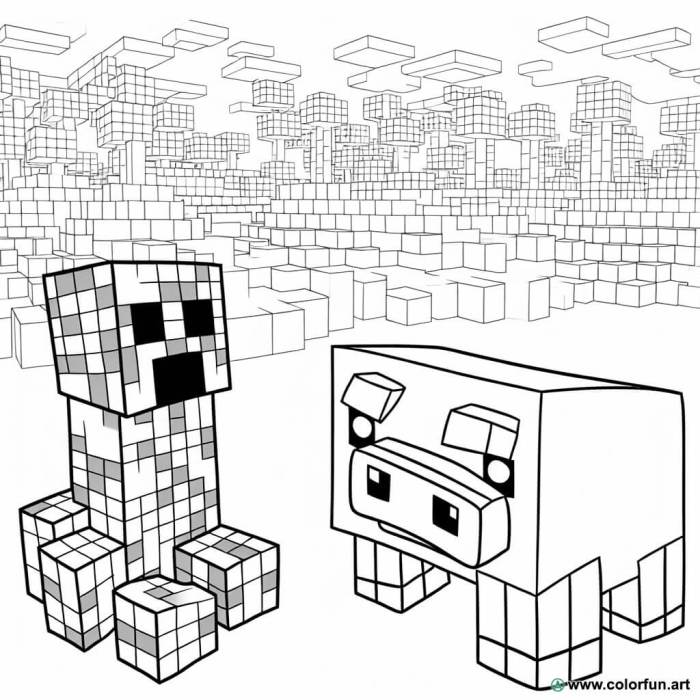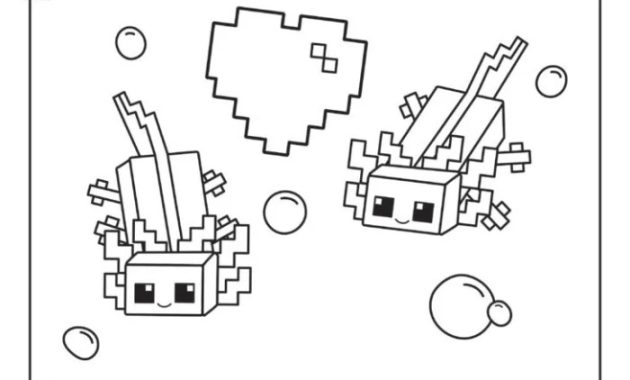Minecraft Animal Popularity

Minecraft animals coloring page – The enduring appeal of Minecraft lies partly in its diverse and charming animal inhabitants. These creatures, ranging from the docile sheep to the more challenging endermen, play significant roles in gameplay, from resource gathering to combat challenges. Their popularity stems from a combination of their in-game utility, their visual appeal, and their presence in the wider Minecraft community.
Determining the precise popularity of each animal is difficult without direct access to comprehensive player interaction data across all platforms. However, considering factors like community discussions, fan art, and the overall prevalence in gameplay videos and streams, a reasonable ranking can be established.
So you’re into Minecraft animals coloring pages? That’s awesome! But have you considered branching out to the shadowy world of nocturnal creatures? Check out this amazing nocturnal animals coloring page for some seriously cool coloring inspiration – imagine a creeper-bat hybrid! Then, armed with your newfound nocturnal knowledge, you can unleash your inner artist on those pixelated Minecraft pals with even more flair.
Top 5 Most Popular Minecraft Animals, Minecraft animals coloring page
This ranking considers player interaction, community engagement (such as fan art and memes), and overall presence in gameplay experiences. It reflects a general consensus, and individual preferences may vary.
- Creeper: The iconic, explosive green creature is undeniably the most recognizable Minecraft animal. Its unpredictable nature and devastating attacks have cemented its place in the game’s lore and popular culture.
- Sheep: Sheep are fundamental to early-game progression, providing wool for crafting. Their simple design and diverse color variations contribute to their widespread appeal.
- Pig: Pigs, easily tamed and bred, serve as a crucial food source and a mount (via saddles). Their simple, approachable design makes them a favorite among players of all skill levels.
- Chicken: Similar to pigs, chickens are a valuable source of food (eggs and cooked chicken). Their relatively common spawns and quirky behavior contribute to their popularity.
- Cow: Cows provide leather and beef, making them essential for survival and crafting. Their calm demeanor and straightforward utility contribute to their consistent presence in Minecraft worlds.
Visual Characteristics of Top 5 Animals
The following table summarizes the key visual characteristics of the top five most popular Minecraft animals.
| Animal | Size | Color(s) | Unique Features |
|---|---|---|---|
| Creeper | Medium | Green | Fuse-like texture, explosive nature |
| Sheep | Medium | White, black, brown, pink, cyan, light gray, gray | Fluffy wool, various colors |
| Pig | Medium | Pink | Snout, short legs |
| Chicken | Small | Brown, white, black | Feathers, distinctive crow |
| Cow | Large | Brown, black and white (spotted) | Four legs, large udders |
Cultural Significance of the Creeper
The Creeper’s cultural impact within the Minecraft community is undeniable. Its unexpected explosions and iconic hissing sound have become synonymous with the game itself. It’s frequently featured in fan art, merchandise, and countless memes. The surprise element of its attacks, often leading to player frustration and death, has ironically contributed to its widespread popularity. The Creeper’s image has transcended the game, becoming a recognizable symbol in online gaming culture.
Coloring Page Design Considerations: Minecraft Animals Coloring Page
Creating engaging and age-appropriate Minecraft animal coloring pages for children aged 5-8 requires careful consideration of design elements. The goal is to produce pages that are both fun to color and easy for young children to manage, avoiding frustration due to overly intricate designs. Simplicity and clear lines are paramount.Designing coloring pages for this age group necessitates a balance between visual appeal and ease of coloring.
Line thickness, simplicity of shapes, and the overall layout are crucial factors influencing a child’s coloring experience. A well-designed page encourages creativity and fosters a positive association with the activity.
Line Thickness and Simplicity
Appropriate line thickness is crucial for ease of coloring. Lines should be thick enough to be easily visible and followed by young children with crayons or colored pencils, but not so thick that they overwhelm the image. A good guideline is to aim for lines that are approximately 3-5 millimeters thick. This allows for comfortable coloring without excessive pressure, minimizing smudging and frustration.
Furthermore, simplicity in the design is key. Avoid overly complex shapes or intricate details that might confuse or overwhelm a young child. Focus on clear, easily recognizable shapes that represent the Minecraft animals. Simple, bold Artikels are preferable to thin, detailed lines.
Coloring Page Layouts
The following examples illustrate three different layout options for a single Minecraft animal coloring page, demonstrating variations in complexity and detail suitable for children aged 5-8.
- Simple Layout: This layout features a single, large image of a Minecraft sheep, with minimal details. The sheep is presented in a simple, almost cartoonish style, with large, easily colorable areas. The Artikel is bold and clear, with no internal details or shading. This is ideal for younger children or those just beginning to color.
- Moderate Layout: This layout shows the same Minecraft sheep, but with slightly more detail. The sheep might have simple facial features like eyes and a nose, and its wool might be divided into distinct sections for easier coloring. The Artikel remains bold and clear, but some internal lines are added to guide coloring within specific areas. This layout is suitable for children with some coloring experience.
- Detailed Layout: This layout presents the Minecraft sheep with more detailed features. It might include more intricate wool patterns, a more detailed face, and possibly even small accessories. The lines are still relatively thick, but the number of lines and sections increases, making it more challenging but still manageable for older children in the target age group.
Incorporating Minecraft-Themed Background Elements
Integrating Minecraft-themed background elements enhances the overall appeal of the coloring page and provides further creative opportunities for children. Here are five unique ideas:
- Pixelated Blocks: The background could feature a simple pattern of pixelated blocks, reminiscent of the Minecraft game world. These blocks could be various colors and arranged in a visually appealing manner, complementing the main animal image without overwhelming it.
- Minecraft Landscape: A simplified Minecraft landscape could serve as a background, including basic elements like grass blocks, trees (represented simply), and perhaps a small mountain range.
- Crafting Table: A simple depiction of a crafting table, with slots for items, could provide a thematic background. The child could even color the “slots” with colors representing different items.
- Tools and Weapons: A scattering of simple representations of Minecraft tools, such as a pickaxe, shovel, or sword, could be incorporated into the background, adding a playful touch.
- Creeper Face: A stylized, simplified Creeper face could be subtly integrated into the background, adding a fun and recognizable Minecraft element. It could be partially hidden or woven into the other background elements.
Animal Characteristics & Coloring

Translating the vibrant, blocky aesthetic of Minecraft animals into a smooth, printable coloring page requires careful consideration of color palettes, shading techniques, and the overall simplification of the pixel art. Successfully achieving this transition will enhance the coloring experience and maintain the recognizable charm of the original Minecraft designs.Color palettes are crucial for retaining the essence of each animal.
The simplification from pixels to smooth lines necessitates a thoughtful approach to color selection to avoid losing the character of the original designs.
Minecraft Animal Color Palettes
The top five most popular Minecraft animals (Creeper, Pig, Sheep, Cow, and Chicken) each boast distinct color schemes integral to their in-game identities. The following analysis details these palettes and their contribution to the animals’ overall design.
- Creeper: Primarily dark green, with a slightly lighter shade for detailing. This creates a sense of lurking menace, consistent with its in-game behavior. Adding subtle shading can enhance the three-dimensionality and menacing presence.
- Pig: Pink is the dominant color, with darker pink accents used for shading and defining features like the snout and ears. This simple palette effectively conveys the animal’s friendly and somewhat plump appearance.
- Sheep: Sheep exhibit a variety of colors in the game, offering diverse coloring page options. The core palette, however, typically involves variations of white, black, pink, light gray, and brown, allowing for a wide range of shading and highlighting possibilities to represent wool texture.
- Cow: Mostly brown and white, with a subtle variation in shades to create depth. The cow’s coloring page should utilize these variations to simulate the patches of fur and create a realistic, yet stylized appearance.
- Chicken: A combination of light brown and yellow-orange, often with darker brown accents for shading and defining features. The color choices contribute to a cheerful, familiar appearance consistent with the in-game model.
Challenges and Opportunities in Translating Pixel Art
Converting Minecraft’s pixel art style into a smooth coloring page presents both challenges and opportunities. The challenge lies in maintaining the recognizable features while smoothing out the blocky shapes. Opportunities arise in enhancing details and adding depth that are difficult to achieve in the pixelated format. For instance, the simplified forms allow for more detailed shading and texture representation, making the coloring process more engaging.
Coloring Process for a Sheep
Let’s focus on a white sheep. Begin by outlining the sheep’s body with a light pencil, defining its rounded form. Then, apply a base coat of white crayon or colored pencil, ensuring even coverage. To create texture resembling wool, apply lighter shades of gray in small, circular strokes throughout the body, focusing on areas where light would naturally hit.
Conversely, use slightly darker grays in the recesses and shaded areas, mimicking the way light and shadow play on fluffy wool. Adding small, darker gray highlights near the edges will further enhance the three-dimensionality. Finally, use very light gray or even a touch of white to add small highlights to emphasize the fluffiness and volume of the wool.
This multi-layered approach will translate the blocky sheep into a soft, textured creature.

